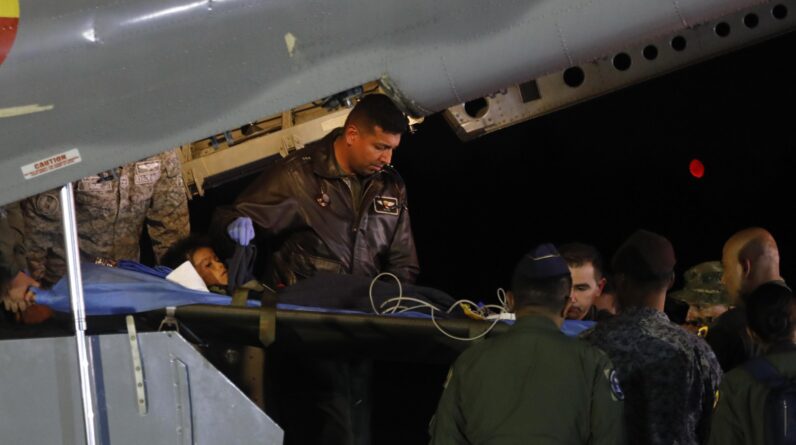
BOGOTA, Colombia (AP) – Four indigenous children survived an Amazon plane crash that killed three adults, then braved the jungle for 40 days before being found alive by Colombian soldiers, giving a happy ending to a search and rescue saga that captivated a nation and forced the military and usually opposing indigenous peoples to work together.
Cassava flour and some familiarity with rainforest fruits were key to the children’s extraordinary survival in an area where snakes, mosquitoes and other animals abound. The members of the Huitoto population, aged 13, 9 and 4 years and 11 months, are expected to stay at least two weeks in a hospital for treatment after their rescue on Friday.
Family members, President Gustavo Petro, as well as government and military officials met with the children Saturday at the hospital in Bogota, the capital. Defense Minister Iván Velásquez told reporters that the children were being rehydrated and still cannot eat food.
“But in general, the condition of the children is acceptable,” Velásquez said. They were traveling with their mother from the Amazonian town of Araracuara to San José del Guaviare when the plane crashed in the early hours of May 1.
The Cessna single-engine propeller plane was carrying three adults and the four children when the pilot declared an emergency due to engine failure. The small plane fell off the radar a short time later and the search for survivors began.
“When the plane crashed, they took a flour (from the wreckage), and with that they survived,” the children’s uncle, Fidencio Valencia, told reporters outside the hospital. Fariña is cassava flour that people eat in the Amazon region.
“After the flour ran out, they started eating seeds,” Valencia said.
The weather was in favor of the children. Astrid Cáceres, head of the Colombian Family Welfare Institute, said the young people were also able to eat fruit because “the jungle was in harvest”.
An air force video released Friday showed a helicopter using lines to pull the youths up because they couldn’t land in the dense rainforest where they found themselves. The army tweeted pictures on Friday showing a group of soldiers and volunteers posing with the children, who were wrapped in thermal blankets. One of the soldiers brought a bottle to the lips of the youngest boy.
General Pedro Sánchez, who was in charge of rescue operations, said the children were found 5 kilometers (3 miles) from the crash site in a small forest clearing. He said rescue teams had gone within 20 to 50 meters (66 to 164 feet) of where the children were found on a couple of occasions, but had lost them.
“The minors were already very weak,” said Sánchez. “And surely his strength was only enough to breathe or reach a small fruit to feed himself or drink a drop of water in the jungle.”
Petro said the children are an “example of survival” and predicted their saga “will go down in history”.
Two weeks after the crash, on May 16, a search team found the plane in a thick part of the rainforest and recovered the bodies of the three adults on board, but the young children were nowhere to be found .
Sensing they might be alive, Colombia’s military stepped up the hunt and flew 150 soldiers with dogs into the area, where fog and thick foliage severely limited visibility. Dozens of volunteers from indigenous tribes also joined the search.
Soldiers in helicopters dropped boxes of food into the jungle, hoping it would help sustain the children. Planes flying over the area fired flares to help search crews on the ground at night, and rescuers used loudspeakers to play a recorded message by the brothers’ grandmother telling them to stay put.
The announcement of their rescue came shortly after President Gustavo Petro signed a ceasefire with representatives of the National Liberation Army rebel group. In line with his government’s message highlighting its efforts to end internal conflicts, he highlighted the joint work of the military and indigenous communities to find the children.
“The meeting of knowledge: indigenous people and the military,” he tweeted. “Here is a different path for Colombia: I think this is the true path of Peace.”
Damaris Mucutuy, the children’s aunt, told a radio station that “the children are fine” despite being dehydrated and with insect bites. He added that the children had received mental health services.
Cáceres told reporters that officials agreed with the children’s relatives to allow “spiritual work” in the jungle and the hospital “if immediate emergency action was not required.” He said musicians and musical instruments relevant to children’s culture will be allowed in the hospital.
Officials praised the courage of the oldest of the children, a girl, who they said had some knowledge of how to survive in the rainforest and carried the children through the ordeal.
Before his rescue, there were rumors about his whereabouts. So much so, that on May 18, Petro tweeted that the children had been found. He then deleted the message, claiming he had been misinformed by a government agency.
The children told officials they spent some time with the dog, but then it disappeared. He was a rescue dog that the soldiers took into the jungle. Troopers were still searching for the dog, a Belgian shepherd named Wilson, on Saturday.
Petro said he had believed for a while that the children were rescued by one of the nomadic tribes that still roam the remote area where the plane went down and have little contact with authorities.
As the search progressed, troopers found small clues that led them to believe the children were still alive, including a pair of footprints, a bottle, diapers and pieces of fruit that appeared to have been bitten by humans.
“The jungle saved them,” Petro said. “They are children of the jungle, and now they are also children of Colombia.”
___
Garcia Cano reported from Mexico City.
[ad_2]
Source link





